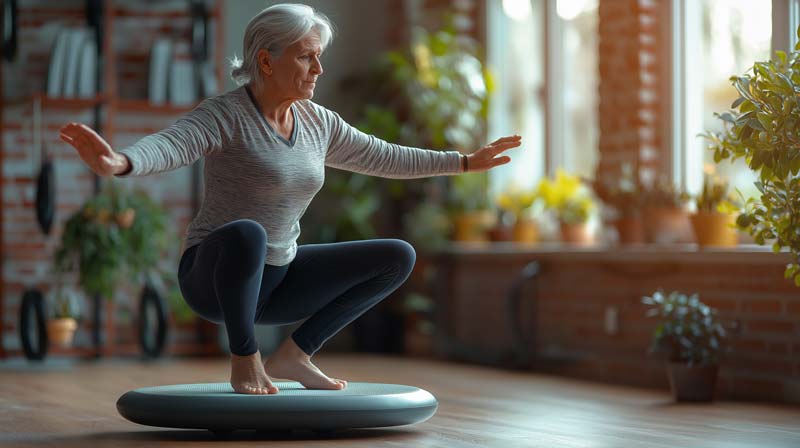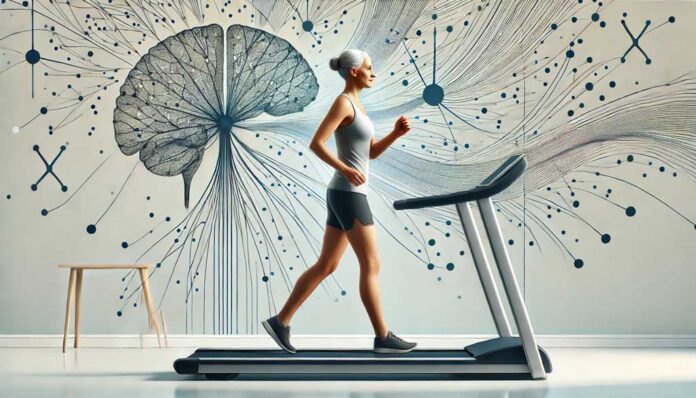Exercise benefits for Parkinson’s disease are a crucial component in managing this complex neurodegenerative disorder. Parkinson’s disease, characterised by the progressive loss of dopaminergic neurons in the substantia nigra (a region in the midbrain), affects approximately 1.6% to 1.8% of individuals aged 65 years or older.
The condition manifests through motor and non-motor symptoms, significantly impacting patients’ quality of life and daily functioning. The World Health Organization reports that the global burden of Parkinson’s has doubled in the past 25 years, with over 8.5 million individuals affected as of 2019.
As our understanding of Parkinson’s disease evolves, so does our management approach. While pharmacological interventions remain the cornerstone of treatment, mounting evidence suggests that exercise plays a vital role in symptom management and potentially disease modification. Research indicates that regular physical activity can improve motor function, balance, and gait in Parkinson’s patients.
The impact of exercise addresses various non-motor aspects of the condition. Sleep dysfunction, a prevalent issue affecting 74-98% of Parkinson’s disease patients, has shown improvements with consistent exercise programs. Furthermore, exercise has demonstrated potential in enhancing cognitive function and mood, two areas often affected by the progression of Parkinson’s disease.
This post will explore the exercise benefits for Parkinson’s disease, including the various beneficial exercises, their impact on motor and non-motor symptoms, and the underlying mechanisms that make physical activity such a powerful tool in managing this condition.
The growing body of evidence supporting exercise as a complementary therapy offers hope for improved quality of life and potentially slower disease progression for those living with Parkinson’s disease.
Understanding Parkinson’s Disease and Physical Performance
Exercise benefits for Parkinson’s disease management play a crucial role in addressing the complex motor and non-motor symptoms associated with this neurodegenerative disorder.
Parkinson’s disease (PD) significantly impacts physical performance, affecting various aspects of motor control and movement. The condition, characterised by the progressive loss of dopaminergic neurons in the substantia nigra (a region in the midbrain responsible for movement control), leads to a range of motor symptoms, including slowness of movement (bradykinesia), muscle stiffness (rigidity), tremor, and postural instability.
These motor symptoms can severely impair an individual’s ability to perform daily activities and maintain independence. For instance, gait disturbances are common in PD, manifesting as reduced step length, slower walking speed, and freezing of gait.
These impairments can significantly impact mobility and independence, challenging simple tasks like walking or turning. Exercise benefits for Parkinson’s disease can help address these gait issues.
Balance and coordination are often severely affected in PD, leading to an increased risk of falls. Individuals with PD may experience difficulties maintaining balance, especially during complex tasks or when changing positions.
This balance impairment is not only a result of motor symptoms but also due to the altered interaction between balance-related systems, including the inner ear (vestibular), eyesight (visual), and body position sense (proprioceptive) systems.
Even in the early stages of PD, measurable disability is present relative to age-matched neurologically healthy controls. Studies have shown that individuals with mild PD (Hoehn and Yahr stages I-II, which indicate early disease progression) report difficulties with activities of daily living (ADLs) and instrumental ADLs.
Approximately 25% of those with mild disease severity experience difficulty walking, which is considered a clinical “red flag” for emerging disability in PD. Exercise benefits for Parkinson’s disease can be particularly crucial in the early stages of maintaining function.

Motor Improvements from Exercise Benefits for Parkinson’s Disease
Exercise interventions have demonstrated significant potential in improving motor symptoms and physical performance in individuals with PD.
These benefits extend across various aspects of motor function, including tremor, rigidity, bradykinesia (slowness of movement), gait, balance, and overall mobility. The exercise benefits for Parkinson’s disease can be observed in multiple areas of motor function. To better understand these improvements, we can categorise them into three main areas:
- Impact of exercise on tremor, rigidity, and bradykinesia
- Improvements in gait, balance, and postural stability
- Effects on overall mobility and functional capacity
Impact on Tremor, Rigidity, and Bradykinesia:
Research has shown that regular exercise can improve the primary motor symptoms of PD. For instance:
- A study involving active-assisted cycling found that this exercise improved tremors and bradykinesia in PD patients.
- High-intensity treadmill exercise has been associated with slowing the progression of motor symptoms in individuals with newly diagnosed PD.
Gait, Balance, and Postural Stability Enhancements:
Exercise interventions have shown promising results in improving gait parameters and enhancing balance and postural stability:
- Intensive treadmill training over six weeks has been found to improve gait and quality of life in PD patients.
- Balance-based exercises, particularly those incorporating virtual reality technology, have demonstrated improvements in postural stability.
Overall Mobility and Functional Capacity:
The benefits of exercise spread to overall mobility and functional capacity in PD patients:
- Incremental speed-dependent treadmill training has been shown to improve postural instability and reduce the fear of falling in individuals with PD.
- High-intensity exercise rehabilitation, combining resistance training and bodyweight interval training, has been found to improve muscle mass, mitochondrial function, and physical capacity in PD patients. These exercise benefits for Parkinson’s disease contribute to improved overall mobility.
These improvements in motor function through exercise can enhance independence in daily activities and improve the quality of life for individuals with PD.
The evidence suggests that a comprehensive exercise program targeting various aspects of motor function can yield significant benefits in managing the motor symptoms of Parkinson’s disease.
Types of Beneficial Exercises for Parkinson’s Patients
PD patients can benefit from various exercise modalities, each offering unique advantages for managing symptoms and improving overall function.
A comprehensive exercise programme for individuals with PD typically includes aerobic exercises, resistance training, and flexibility and balance exercises. These different types of exercises work synergistically to address the multifaceted challenges posed by PD.
Aerobic Exercises:
Aerobic activities form a crucial component of exercise programmes for PD patients. These exercises improve cardiovascular fitness, often compromised in individuals with PD. Common aerobic exercises beneficial for PD patients include:
- Treadmill walking: This activity can help improve gait parameters and overall mobility. Studies have shown that treadmill training can improve walking speed and stride length in PD patients.
- Cycling: Both stationary and outdoor cycling can be beneficial. Cycling has been associated with improvements in tremor and bradykinesia in PD patients.
- Swimming: This low-impact exercise provides a full-body workout while reducing joint stress, making it particularly suitable for individuals with balance issues.
Resistance Training:
Strength training exercises are essential for maintaining muscle mass and improving overall physical function in PD patients. Resistance training can help counteract the muscle weakness often associated with PD. Beneficial resistance exercises include:
- Body weight exercises: These can be easily adapted to different fitness levels and improve functional strength.
- Resistance bands: These versatile tools provide adjustable resistance and can be used for various exercises.
- Free weights and weight machines: When used under proper supervision, these can provide practical strength training for PD patients.
Flexibility and Balance Exercises:
These exercises are crucial for improving postural stability and reducing the risk of falls in PD patients. Effective flexibility and balance exercises include:
- Yoga: This practice combines stretching, balance, and mindfulness, offering multiple benefits for PD patients.
- Tai Chi: Studies have shown that Tai Chi can improve balance and reduce fall risk in individuals with PD.
- Stretching routines: Regular stretching can help maintain flexibility and range of motion, often compromised in PD.
The exercise benefits for Parkinson’s disease extend across these various exercises, with each modality contributing to overall symptom management and improved quality of life.
It’s important to note that exercise programmes should be tailored to the individual’s specific needs, capabilities, and disease stage to ensure safety and effectiveness.
Non-Motor Exercise Benefits for Parkinson’s Disease
While the motor benefits of exercise for PD are well-documented, research increasingly highlights the significant impact of physical activity on non-motor symptoms.
These non-motor symptoms, including cognitive impairment, mood disorders, and sleep disturbances, can substantially affect the quality of life for individuals with PD. Exercise benefits Parkinson’s disease, gives physical improvements, and offers a holistic approach to symptom management.
Cognitive Function Improvements:
Regular physical activity has shown promising effects on cognitive function in PD patients:
- A randomised controlled trial demonstrated that aerobic exercise could improve executive function, a cognitive domain often affected by PD. Participants performed better on tasks sensitive to executive deficits following an exercise intervention.
- High-intensity exercise has been associated with changes in brain activation patterns similar to those seen after levodopa administration, suggesting a potential neuroprotective effect.
Impact on Mood and Mental Health:
Exercise can play a crucial role in managing mood disorders commonly associated with PD:
- Studies have reported improvements in depression and anxiety symptoms following regular exercise programmes. These mood enhancements can contribute significantly to PD patients’ overall well-being and quality of life.
- The social aspect of group exercise classes can provide additional psychological benefits, fostering a sense of community and reducing feelings of isolation often experienced by individuals with PD.
Sleep Quality and Fatigue Management:
Sleep disturbances and fatigue are common non-motor symptoms in PD that can be positively influenced by exercise:
- A 16-week high-intensity exercise intervention significantly improved objective sleep outcomes in PD patients, including sleep efficiency, total sleep time, and slow-wave sleep.
- Regular physical activity has been associated with reduced daytime sleepiness and improved overall sleep quality, which can have far-reaching effects on daily functioning and quality of life.
The exercise benefits for Parkinson’s disease in addressing these non-motor symptoms highlight the importance of a comprehensive approach to PD management.

Safety Considerations and Precautions
Although exercise offers numerous benefits for individuals with PD, it’s crucial to approach physical activity carefully, considering safety and individual limitations.
Tailoring exercise programmes to each person’s capabilities and specific symptoms is essential for maximising benefits whilst minimising risks.
Individual Assessment and Programme Design:
Before beginning any exercise program, individuals with PD should undergo a thorough assessment by healthcare professionals. This evaluation helps determine:
- The current stage of the disease
- Existing physical limitations
- Potential contraindications to certain types of exercise
Based on this assessment, a personalised exercise programme can be developed, considering the individual’s needs, preferences, and goals. The exercise benefits for Parkinson’s disease are most pronounced when the programme is tailored to the individual.
Potential Risks and Mitigation Strategies:
Though exercise is generally safe for PD patients, certain risks should be considered:
- Fall risk: Given the balance and gait issues common in PD, exercises should be performed safely with proper support when necessary. Using a gait belt during treadmill tests or exercises can provide additional safety.
- Cardiovascular considerations: Some individuals with PD may have autonomic dysfunction, which can affect blood pressure regulation. Monitoring blood pressure during exercise, especially in the early stages of a new programme, is advisable.
- Fatigue management: PD patients may experience fatigue more quickly than others. It’s important to balance exercise intensity with adequate rest periods to prevent exhaustion.
Guidelines for Safe Exercise Practices:
To ensure safety during exercise, individuals with PD and their caregivers should follow these guidelines:
- Start slowly and gradually increase the intensity and duration of exercise sessions.
- Use proper equipment and ensure a safe exercise environment.
- Stay hydrated and be aware of any signs of overexertion.
- Consider exercising when medication effects are optimal (“on” periods).
- Be aware of the potential for orthostatic hypotension, especially when changing positions quickly.
The exercise benefits for Parkinson’s disease can be safely realised by observing these precautions and guidelines. Regular communication with healthcare professionals about the exercise program and any changes in symptoms or capabilities is crucial for ongoing safety and effectiveness.
Exercise plays a vital role in managing Parkinson’s disease, offering a range of benefits that extend from motor improvements to enhanced cognitive function and quality of life.
By understanding the types of beneficial exercises, recognising the broad spectrum of benefits, and following the necessary safety precautions, individuals with PD can harness the power of physical activity to better manage their symptoms and potentially slow disease progression.
As research in this field continues to evolve, the importance of exercise as a cornerstone of PD management becomes increasingly evident. Exercise provides hope and tangible improvements for those living with this challenging condition.
Sources
- Amara AW, Wood KH, Joop A, et al. Randomised, Controlled Trial of Exercise on Objective and Subjective Sleep in Parkinson’s Disease. Mov Disord. 2020 Jun;35(6):947-958.
- Beall EB, Lowe MJ, Alberts JL, Frankemolle AM, Thota AK, Shah C, Phillips MD (2013) The effect of forced-exercise therapy for Parkinson’s disease on motor cortex functional connectivity. Brain Connect 3, 190–198.
- Cakit BD, Saracoglu M, Genc H, et al.: The effects of incremental speed-dependent treadmill training on postural instability and fear of falling in Parkinson’s disease. Clin Rehabil. 2007;21:698–705.
- Cameron IGM, Watanabe M, Pari G, Munoz DP. Executive impairment in Parkinson’s disease: response automaticity and task switching. Neuropsychologia 2010;48:1948–1957.
- Corcos DM, Robichaud JA, David FJ, et al. A two-year randomised controlled trial of progressive resistance exercise for Parkinson’s disease. Mov Disord 2013;28(09):1230–1240.
- Gallo PM, Garber CE: Parkinson’s disease: a comprehensive approach to exercise prescription for the health fitness professional. ACSM’s Health Fitness J. 2011;15:8–17.
- Goodwin VA, Richards SH, Taylor RS, Taylor AH, Campbell JH. The effectiveness of exercise interventions for people with Parkinson’s disease: a systematic review and meta-analysis. Movement Disorders 2008;23(5):631-40.
- Haapaniemi TH, Kallio MA, Korpelainen JT, et al. Levodopa, bromocriptine and selegiline modify cardiovascular responses in Parkinson’s disease. J Neurol. 2000;247(11):868–74.
- Herman T, Giladi N, Gruendlinger L, et al.: Six weeks of intensive treadmill training improves gait and quality of life in patients with Parkinson’s disease: a pilot study. Arch Phys Med Rehabil. 2007;88:1154–8.
- Hughes AJ, Daniel SE, Kilford L, Lees AJ. Accuracy of clinical diagnosis of idiopathic Parkinson’s disease: a clinico-pathological study of 100 cases. Journal of Neurology, Neurosurgery, and Psychiatry 1992;55(3):181-4.
- Kelly NA, Ford MP, Standaert DG, et al.. Novel, high-intensity exercise prescription improves muscle mass, mitochondrial function, and physical capacity in individuals with Parkinson’s disease. Journal of applied physiology. 2014;116(5):582–592.
- Keus SH, Bloem BR, Hendriks EJ, Bredero-Cohen AB, Munneke M, Practice Recommendations Development Group. Evidence-based analysis of physical therapy in Parkinson’s disease with recommendations for practice and research. Mov Disord. 2007;22(4):451–60.
- Kowal SL, Dall TM, Chakrabarti R, Storm MV, Jain A. The current and projected economic burden of Parkinson’s disease in the United States. Mov Disord 2013;28(03):311–318.
- Lees AJ, Blackburn NA, Campbell VL. The nighttime problems of Parkinson’s disease. Clin Neuropharmacol. 1988;11(6):512–519.
- Li F, Harmer P, Fitzgerald K, et al. Tai chi and postural stability in patients with Parkinson’s disease. N Engl J Med 2012;366(06):511–519.
- Nieuwboer A, Kwakkel G, Rochester L, Jones D, Van Wegen E, Willems AM, et al. Cueing training in the home improves gait-related mobility in Parkinsons disease: the RESCUE trial. Journal of Neurology, Neurosurgery and Psychiatry 2007;78(2):134-40.
- Petzinger GM, Fisher BE, McEwen S, et al. Exercise-enhanced neuroplasticity targeting motor and cognitive circuitry in Parkinson’s disease. Lancet Neurol. 2013;12:716–26.
- Ridgel AL, Peacock CA, Fickes EJ, et al.: Active-assisted cycling improves tremor and bradykinesia in Parkinson’s disease. Arch Phys Med Rehabil. 2012;93:2049–54.
- Schenkman M, Moore CG, Kohrt WM, et al. Effect of high-intensity treadmill exercise on motor symptoms in patients with de novo Parkinson disease: a phase 2 randomised clinical trial. JAMA Neurol 2018;75(02):219–226.
- Shih MC, Wang RY, Cheng SJ, Yang YR. Effects of a balance-based exergaming intervention using the Kinect sensor on posture stability in individuals with Parkinson’s disease: a single-blinded randomised controlled trial. J Neuroeng Rehabil. 2016;13:78.
- Shulman LM, Gruber-Baldini AL, Anderson KE, et al. The evolution of disability in Parkinson disease. Mov Disord 2008;23(06):790–796.
- Werner WG, DiFrancisco-Donoghue J, Lamberg EM. Cardiovascular response to treadmill testing in Parkinson disease. J Neurol Phys Ther. 2006;30(2):68–73.
- World Health Organization. Parkinson Disease Key Fact.
- Wu C, Xu Y, Guo H, Tang C, Chen D, Zhu M. Effects of aerobic exercise and mind-body exercise in Parkinson’s disease: a mixed-treatment comparison analysis. Frontiers in Aging Neuroscience 2021 Nov 18 [Epub ahead of print].



